Ever dream about having a Japanese Breakfast Nook where every morning feels calm, cozy, and kinda magical? You’re in the right place! Whether your kitchen is teeny-tiny or you’re just craving a fresh vibe, this guide’s got you covered.
We’ll chat about how Japanese design brings zen to small spaces, the secret to making clutter vanish, and even clever ways to turn your nook into a work-friendly zone (because, hey, sometimes breakfast and emails happen side by side). Ready to get inspired and maybe upgrade your mornings for good? Let’s dive in!
Tea Ceremony Principles for Compact Morning Spaces
Let’s be real—mornings can get a little hectic, especially if you’re stuck with a tiny kitchen. But here’s some good news: you can use Japanese tea ceremony vibes to turn even the smallest space into your own peaceful zone. Grab your slippers, pour a cup of something you love, and I’ll walk you through how the big ideas—harmony, respect, purity, and tranquility—make your Japanese Breakfast Nook feel a little magical.
Wa (Harmony) Through Minimalist Layouts
Harmony is all about balance, and that’s super important when you’re working with a small nook. Think of it like putting together your favorite outfit—you want things to match, but it shouldn’t feel forced.


Go Simple with a Low Table and Floor Cushions
A low table (called a chabudai) gives you a cozy spot that doesn’t eat up your whole kitchen. Add some plush floor cushions (zabuton) in soft, neutral colors, and you’ve got instant Zen. The cool thing is you can fold up those legs and stash everything away if you need more space.
Put Objects Together Like Puzzle Pieces
Every piece in your nook should feel like it belongs—kind of like how your favorite teapot just looks right next to your coffee mug. Even a single flower can tie the room together.
You don’t need a “perfect” nook, by the way. If you feel calm and comfortable, you nailed it.
How to: Try moving things around until the space feels “just right” to you. Trust your own taste more than anyone else’s!
Kei (Respect) in Material Selection and Care
Let’s talk about respect—not just for people, but for your stuff too. When you treat your breakfast nook like it matters, it really does feel special.
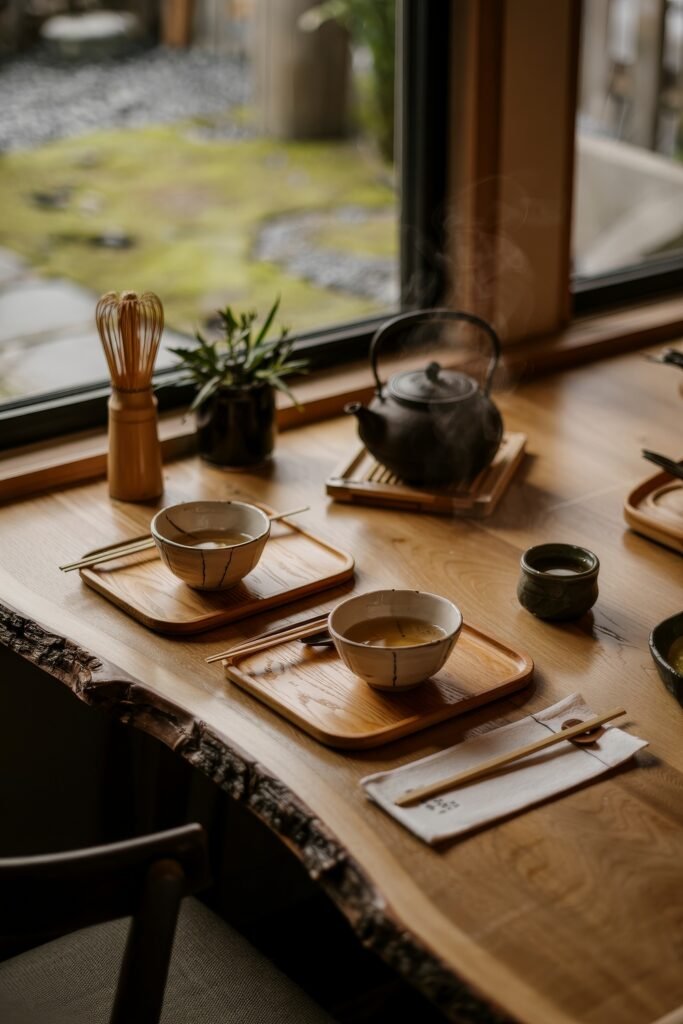
Pick Natural, Real Materials
Go for tables made from real wood (like cedar or ash) and not the fake plastic stuff. If you see a knot or a bump in the wood, that’s cool! Handmade bowls and napkins make every meal feel a little extra.
Make Cleaning Part of the Ritual
Wiping down your table or straightening your cushions is a mini act of gratitude. Weird to say, but cleaning actually becomes peaceful instead of a chore if you do it with some care.
Pretty soon, you’ll look forward to breakfast—not just for the food, but for the little sense of peace you get.
Quick tip: If you want easy upkeep, go for a table with a smooth finish—you get all that natural beauty and still wipe it clean in seconds.
Sei (Purity) via Decluttered Countertops
Raise your hand if clutter stresses you out (my hand is definitely up). Purity in your nook is about keeping things clean and open, so your brain can finally chill.
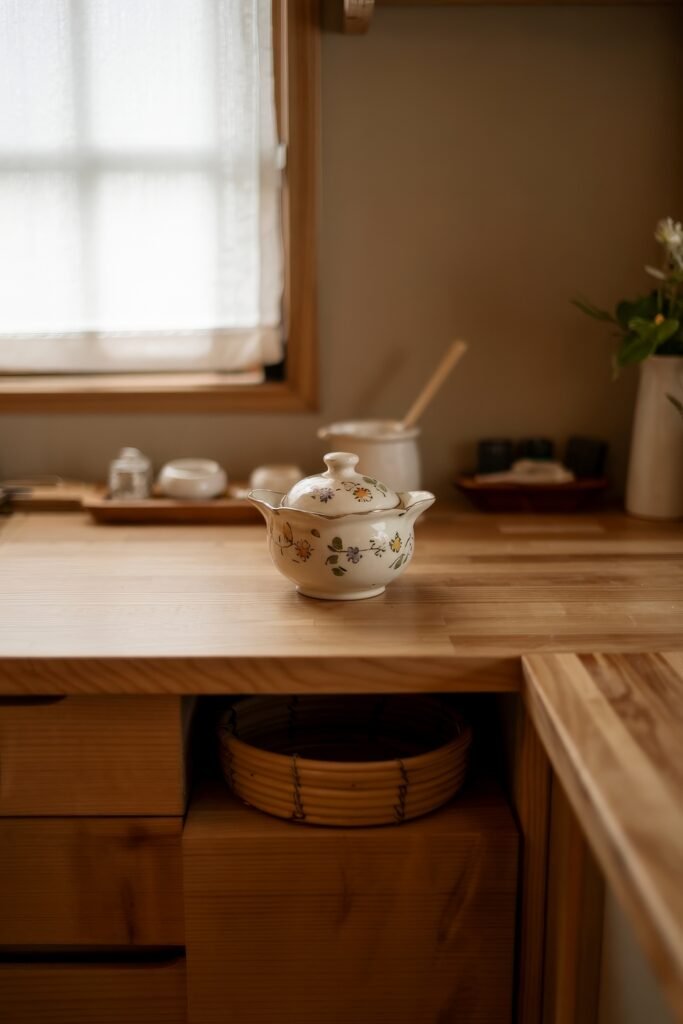
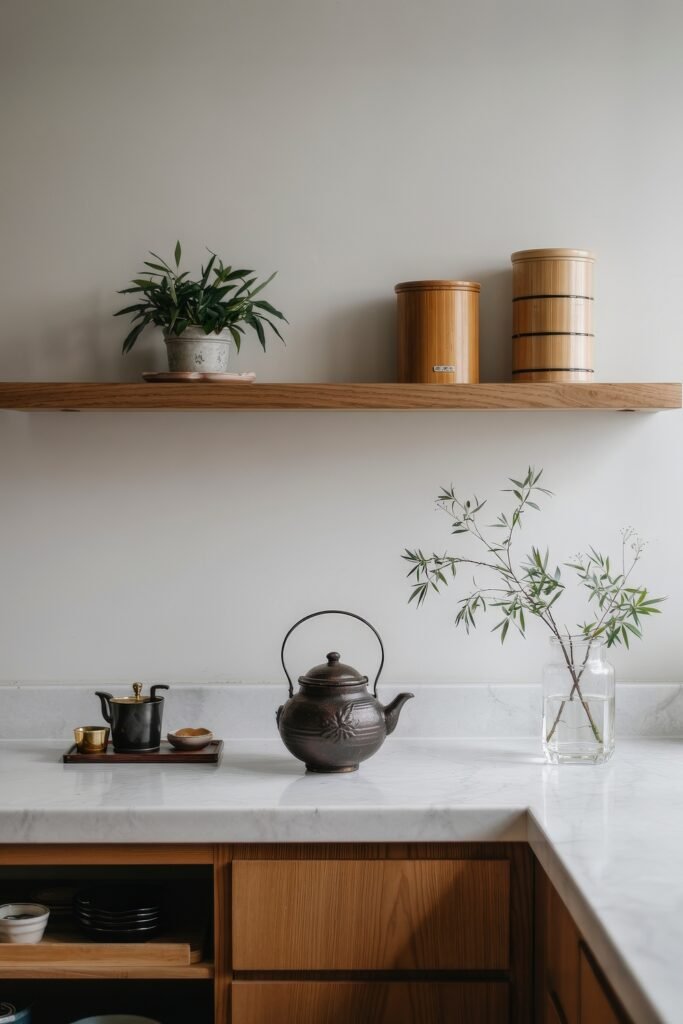
Tuck Stuff Away in Clever Storage
Keep utensils in small baskets or drawers under the table. Show off just one cool sugar bowl or special item—no need to line up twenty things.
Use Open Shelves Wisely
Put up a few shelves to show off pretty tea canisters, but leave some space between objects. Think of empty space as a breather for your eyes.
With a purified space, your morning coffee or cup of matcha becomes a real break from the chaos.
How to: Try a “one in, one out” rule—if you buy something new for your nook, put something old in storage or donate it!
Jaku (Tranquility) with Natural Light and Sound
Ah, tranquility—that feeling when you finally sit down and the world gets quieter. You can actually design your nook to help you find that calm.

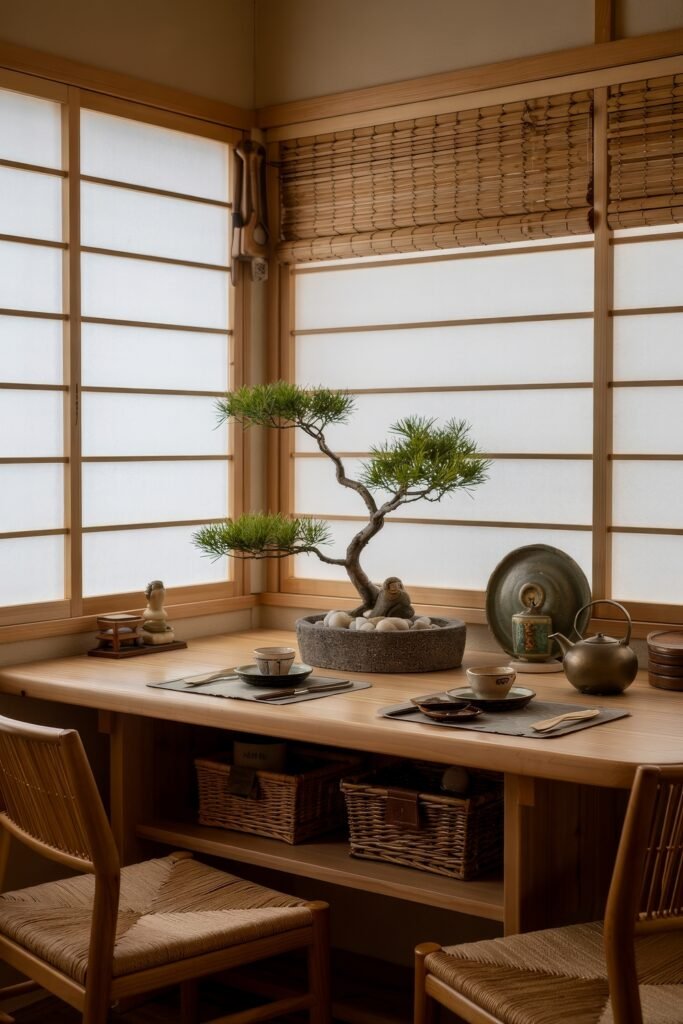
Let Natural Light In
Light curtains inspired by traditional Japanese screens (shoji) let in gentle morning light. It’s like waking up in a forest (sort of).
Add Peaceful Sounds and Greenery
A little tabletop fountain brings in soothing water sounds. Pop a plant nearby (like a bonsai or pothos) to keep things feeling fresh.
By evening, swap in a soft, glowing paper lantern so your nook always feels peaceful.
Take a minute to pause and really notice how your nook sounds, feels, and looks. That’s what makes tiny kitchens special.
A quick how-to: Don’t have a fountain? Play a nature sound playlist while you sip your tea. Instant calm, minus the splashes!
Essential Elements of a Japanese Breakfast Nook
Now that you’re in the Zen mood, let’s get practical. The best Japanese Breakfast Nook is a mix of tradition, comfort, and clever design. Here’s what you need for an easy makeover—no giant remodel required!
Chabudai Tables as Multifunctional Anchors
The chabudai is basically the superhero of small kitchen tables—low, simple, and surprisingly versatile.
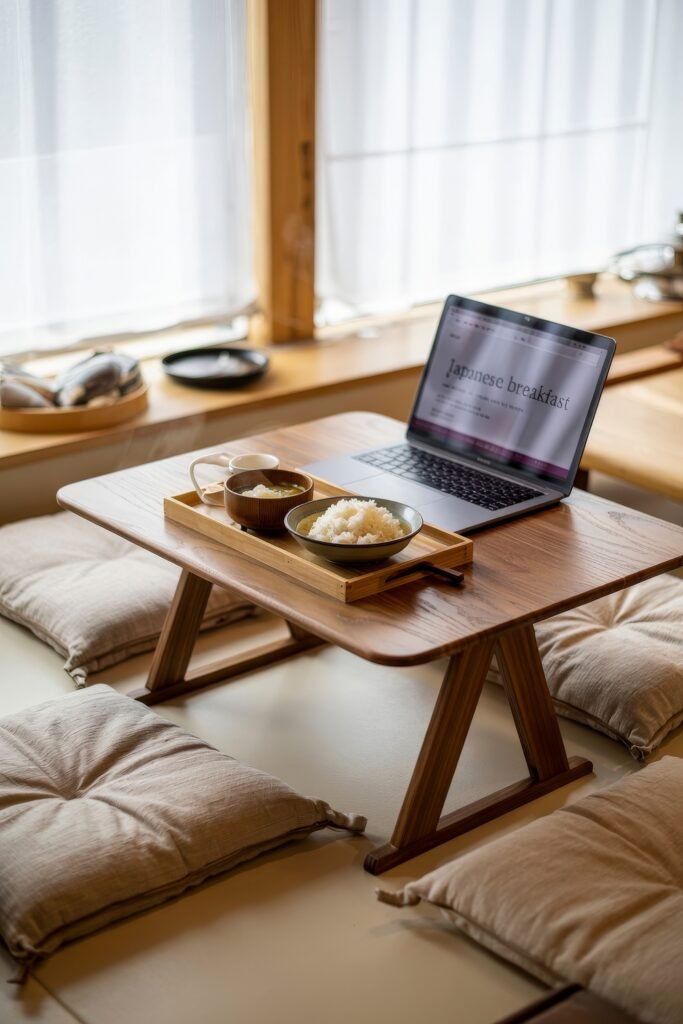
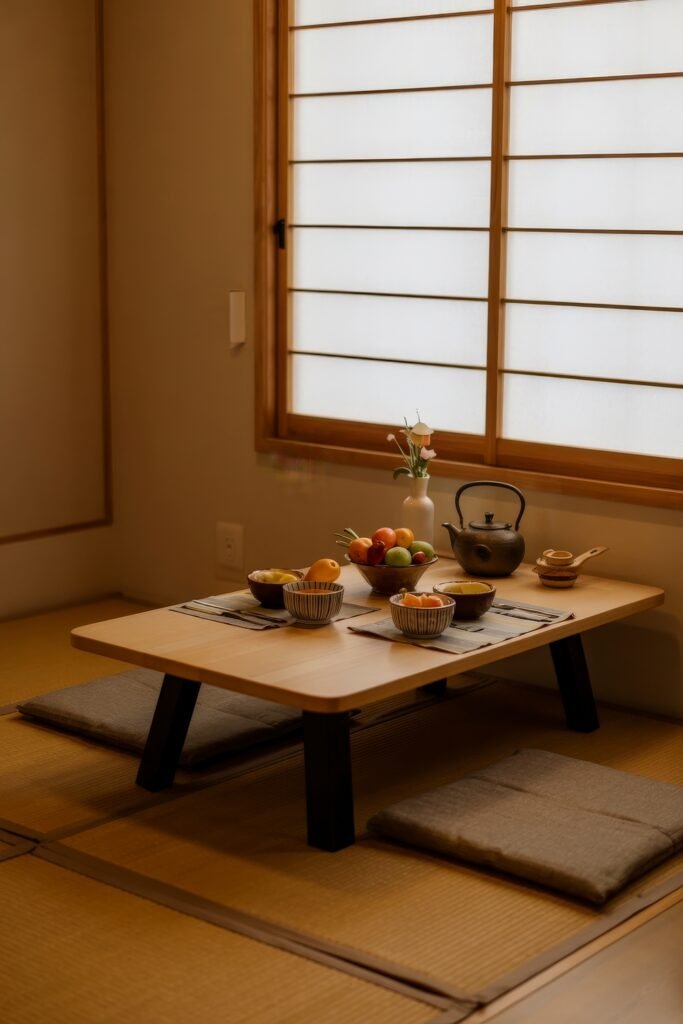
Multipurpose Table for Any Space
Originally used for dining, studying, and even hanging out, the chabudai’s low design makes it fit almost anywhere. You can find versions with legs that pop up and down, or ones where you can change the height.
Great for Work and Play
During the day, use it as a desk. Dinner time? It becomes your dining spot. The whole “one table, many jobs” thing totally works in small homes.
A simple table can honestly make all the difference. Less is more—and this piece proves it.
Pros & Cons: Chabudai tables look cool and don’t take up much space, but be ready to sit on the floor. If that’s not your thing, stash some folding stools nearby.
Zabuton Cushions for Flexible Floor Seating
For all the floor-sitters or folks who want a change from regular chairs, zabuton are game-changers.
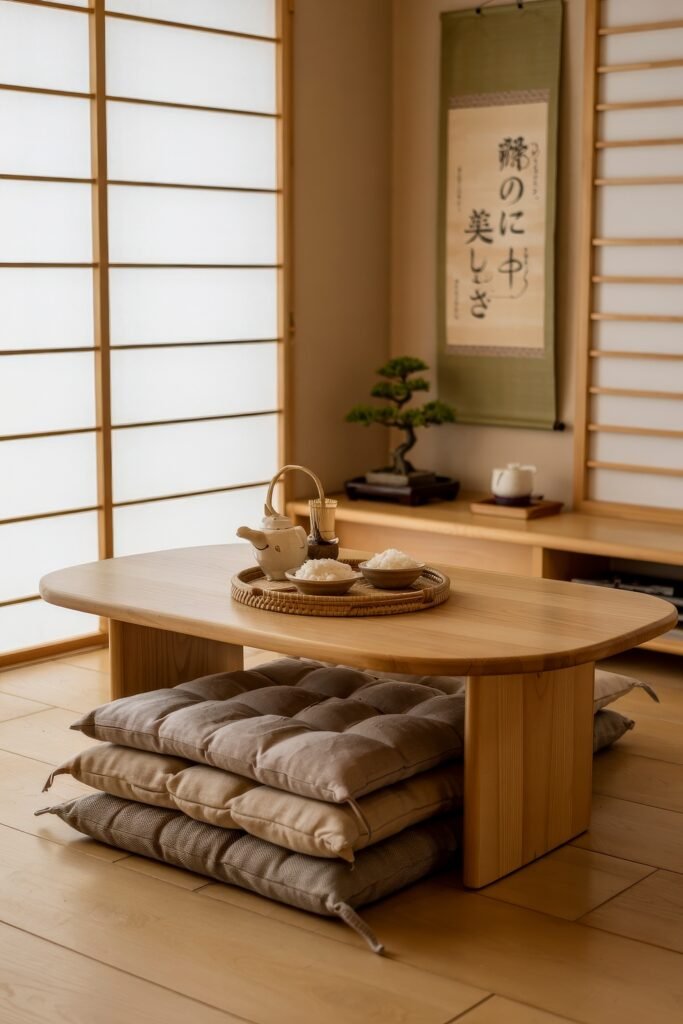
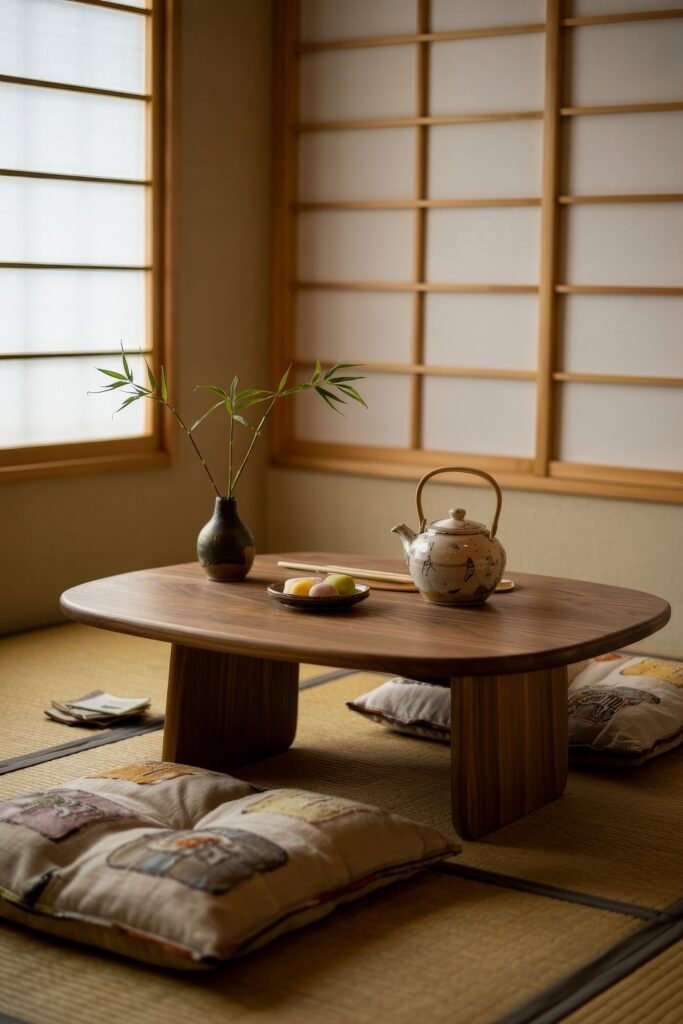
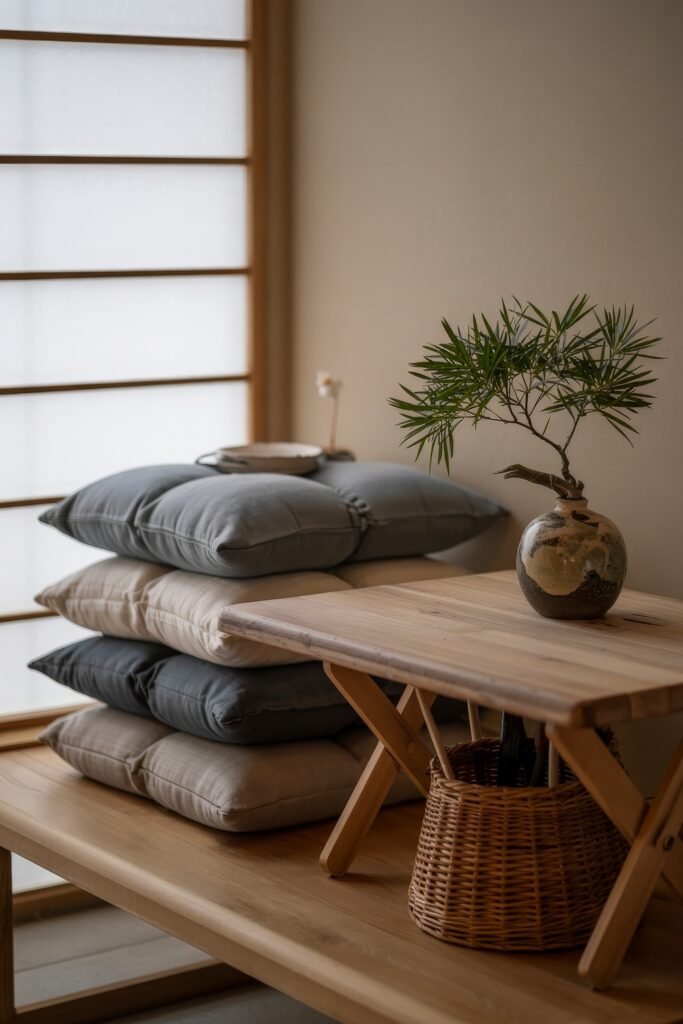
Comfy, Portable Floor Pillows
These rectangular cushions make sitting on the floor way comfier. Stuffed with soft fill like kapok or foam, they’re rooted in tea ceremony traditions—but you don’t have to be fancy to enjoy them.
Layer Up If Needed
Not into sitting low? Stack them on a folded futon for extra padding. They’re light, so you can lift and hide them away whenever you want.
Zabuton make your nook feel inviting, not cramped. Plus, they look great in a neat stack.
A short tip on styling: Mix and match covers—pick a couple patterns and colors to give your nook some personality. Swapping covers out is the fastest refresh ever.
Tatami-Inspired Textures for Tactile Warmth
You don’t need full-on tatami mats to bring Japanese style home. A few subtle details will cozy up your nook.


Go for Tatami-Style Rugs
Small rush-grass rugs offer the classic look, plus they’re good for keeping things humid and muffling noise.
Bamboo and Shoji Accents
Place bamboo mats on the table, or add shades inspired by shoji screens for window treatments. It’s a quick nod to tradition, no commitment needed.
Just touching these natural textures can help you feel connected to nature—even from your apartment.
Practical hacks and tips: Rush mats get softer with use. If one starts to look a little worn, flip it over for a “like new” feel!
Space-Saving Techniques from Traditional Washitsu
Tiny kitchen? No sweat. Japanese homes have mastered small-space living for centuries. Here’s how traditional tricks can make your nook a tidy powerhouse, too.
Vertical Storage Inspired by Tansu Chests
Whoever invented the tansu chest was a genius—these things turn walls into secret storage central.

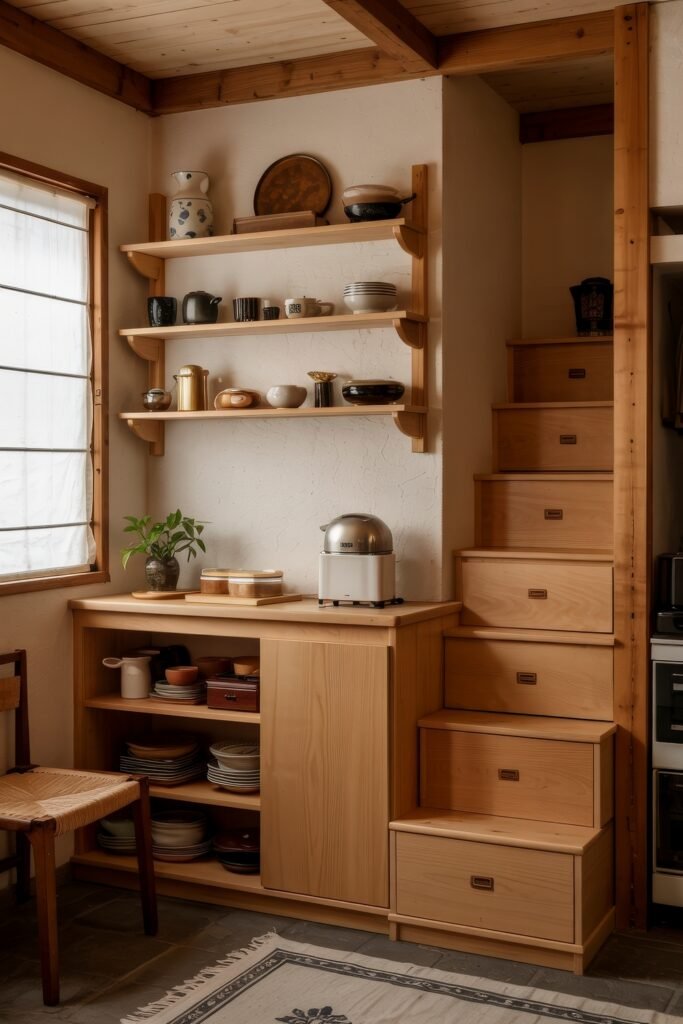
Tall, Skinny Shelves to the Rescue
Vertical shelves (just like old tansu chests) go all the way up the wall, saving precious floor space. Some even have sliding doors or hidden drawers—perfect for hiding your favorite teas or breakfast supplies.
Step-Style Drawers
Think mini stairs made of drawers. They give you spots for spices, napkins, or even your morning jam, all while looking cool and a bit quirky.
You can easily turn a boring wall into something both pretty and practical with these storage solutions.
How to incorporate: Mount shelves at different heights, and don’t be afraid to use that awkward corner. You’ll suddenly have room for stuff you used to keep in a junk drawer!
Foldable Furniture Mimicking Futon Efficiency
Furniture that tucks away when you’re not using it? Yes, please!
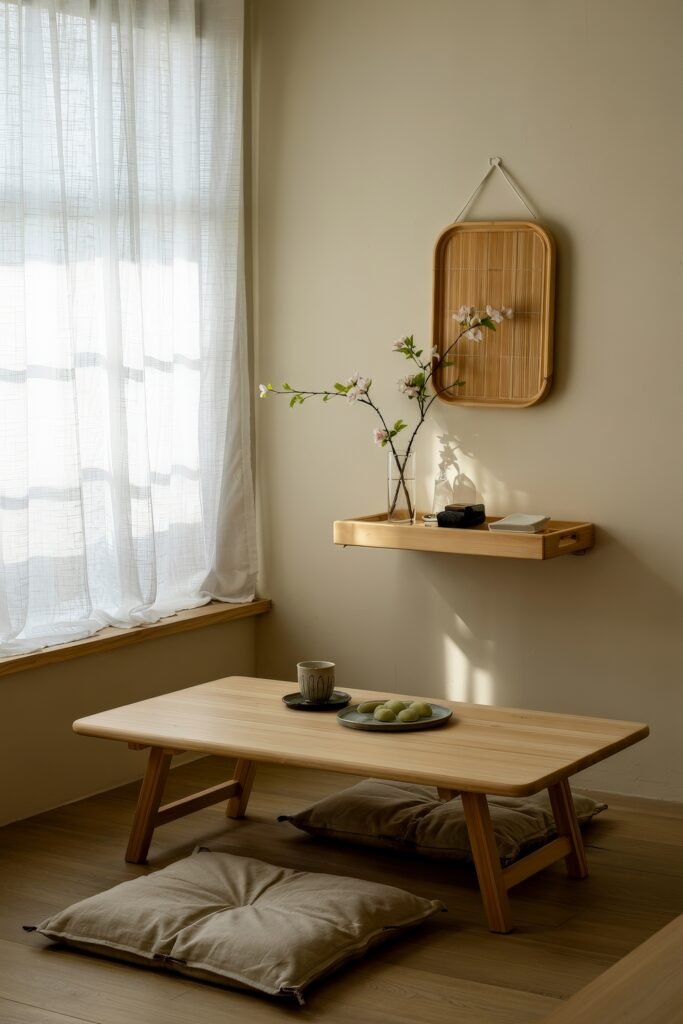
Tables and Cushions That Disappear
When breakfast is over, fold up the legs on your chabudai—and maybe even stack the zabuton in a hidden spot. It’s just like rolling away a futon in a traditional Japanese home.
Multi-Use Breakfast Trays
A tray for eating can double as a shelf when hung on the wall. It’s all about that “grab-and-go” lifestyle.
You’ll find yourself with more open floor space for yoga, a dance break, or just stretching out.
A quick how-to: Look for furniture with handles or folding parts. They’re easier to move and store—plus, your back will thank you.
Sliding Partitions for Adaptive Zoning
Open kitchens are trendy, but sometimes you want a bit of privacy—or just to hide the dishes.
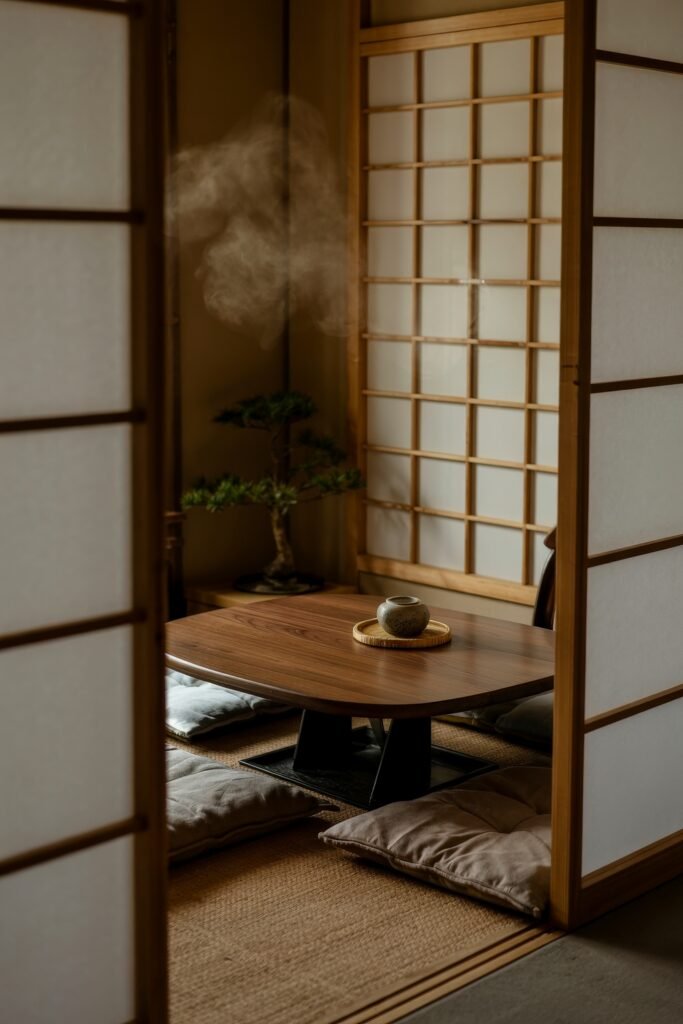
Shoji Screens Do It All
Slide ’em open for a wide, airy feel, or close them for a bit of separation between your nook and the kitchen mess.
Fabric Curtains as Dividers
If screens are too bulky, try hanging a fabric curtain (called noren) for a quick zone change. Go bright and cheerful, or pick something subtle for calm mornings.
It’s all about flexibility. You can open things up or tuck them away, depending on your mood.
Security and safety tips: If you live with pets or kids, make sure your partitions are sturdy and won’t tip. Lightweight screens and velcro curtains work great for busy homes!
Wabi-Sabi Aesthetics in Modern Breakfast Corners
Let’s get artsy for a second. Wabi-sabi is all about loving the perfectly imperfect—like your favorite mug with a chipped handle or a table that’s been through a few spills.
Embracing Imperfections in Handcrafted Tableware
Your dishes don’t have to match. In fact, they shouldn’t! Unique pieces have more personality.
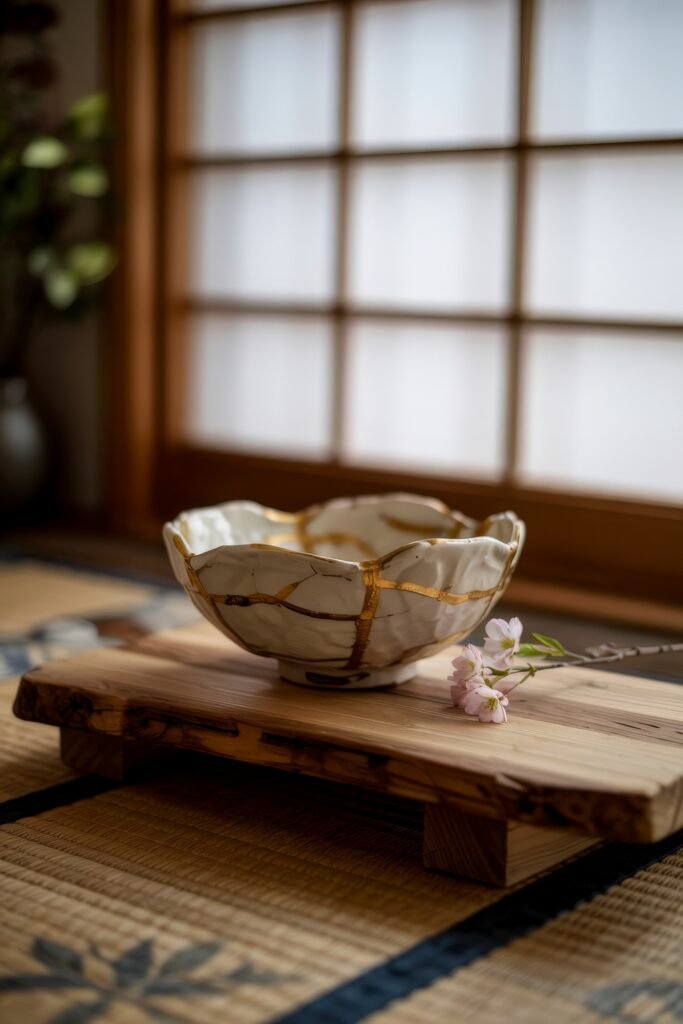
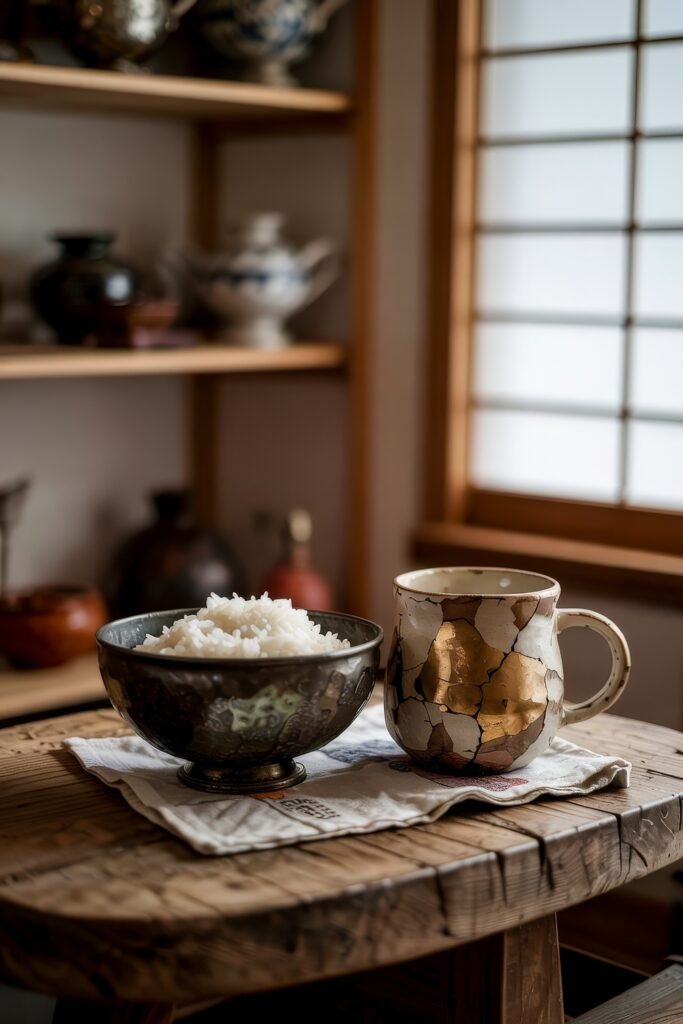
Celebrate Handmade Charm
A tea bowl with an uneven rim, a plate with a wonky glaze—these are the stars of wabi-sabi. They feel good to hold and look cool, too.
Repairs That Add Character
Don’t hide the cracks—fix them with a little gold paint (just like kintsugi). Suddenly, your chipped bowl tells a story.
You’ll enjoy breakfast even more when you’re eating from dishes that show a little age and character.
A quick how-to: If you break a bowl you love, try repairing it instead of tossing it out. Even a little visible glue adds personality—plus, you save money!
Aged Wood Finishes That Tell a Story
Don’t worry if your table isn’t showroom-new. Marks and scuffs only make it better!

Go for Visible Wood Grain
A table with big knots and uneven coloring is perfect. Sun-bleached, scratched, or a little wonky? Even better.
Add Hand-Carved Finds
Find a chair or shelf with uneven edges or little hand-made details. They’re like having a bit of nature inside.
Think of every little imperfection as proof your nook is really lived in.
How to: Raid thrift shops and flea markets for old wood furniture—they’re a goldmine for wabi-sabi gems.
Asymmetrical Arrangements for Organic Charm
Perfection is boring—move things around for that “just right” balance.

Off-Center Flowers, Stacked Cushions
Put a single flower to the side, not smack in the middle of the table. Stack your cushions a little uneven, or angle your lamp so it casts interesting shadows.
Mix and Match Your Tableware
Try a round plate with a square bowl, or line up your teapot and soy cruet off to the side.
When things aren’t perfectly lined up, your breakfast nook feels way more relaxed (and less like a catalog).
A short tip on styling: Every month, switch around your arrangements. It keeps your nook fresh and lets you try new looks—no shopping required!
Multifunctional Solutions for Apartment Living
Japanese design is all about dual-purpose everything, especially when you’re short on space. Your Japanese Breakfast Nook can morph from breakfast, to work, to hangout—whatever you need, whenever you need it.
Chabudai-to-Desk Conversions for Remote Work
Every home office needs a solid desk—but what if you could eat pancakes there, too?
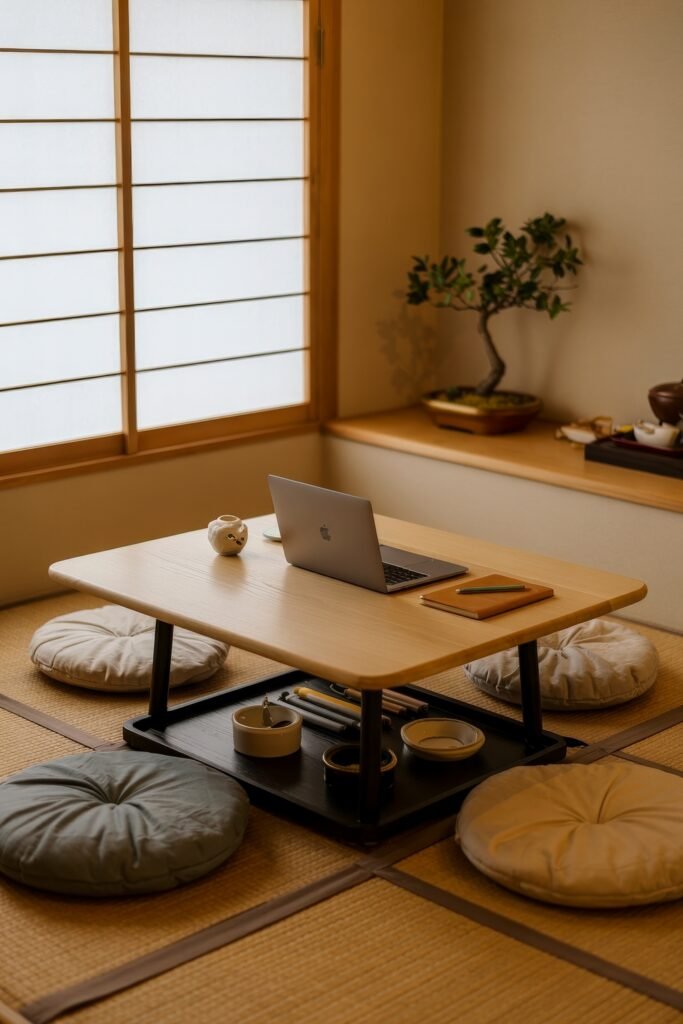
Instant Desk Mode
Use your chabudai as a workspace by adding a cushion or even a low chair. Some tables even have sneaky shelves for charging cords or keeping your pens nearby.
Choose Your Height
If floor sitting isn’t your jam, get a chabudai you can raise up to regular desk level.
Your nook will never be wasted space, even if you’re all about that “work from home” life.
A quick how-to: A rolling cart nearby makes it easy to stash work supplies after you clock out—so your office disappears and breakfast returns!
Zabuton Stacks Doubling as Ottoman Storage
Who knew cushions could be storage ninjas?
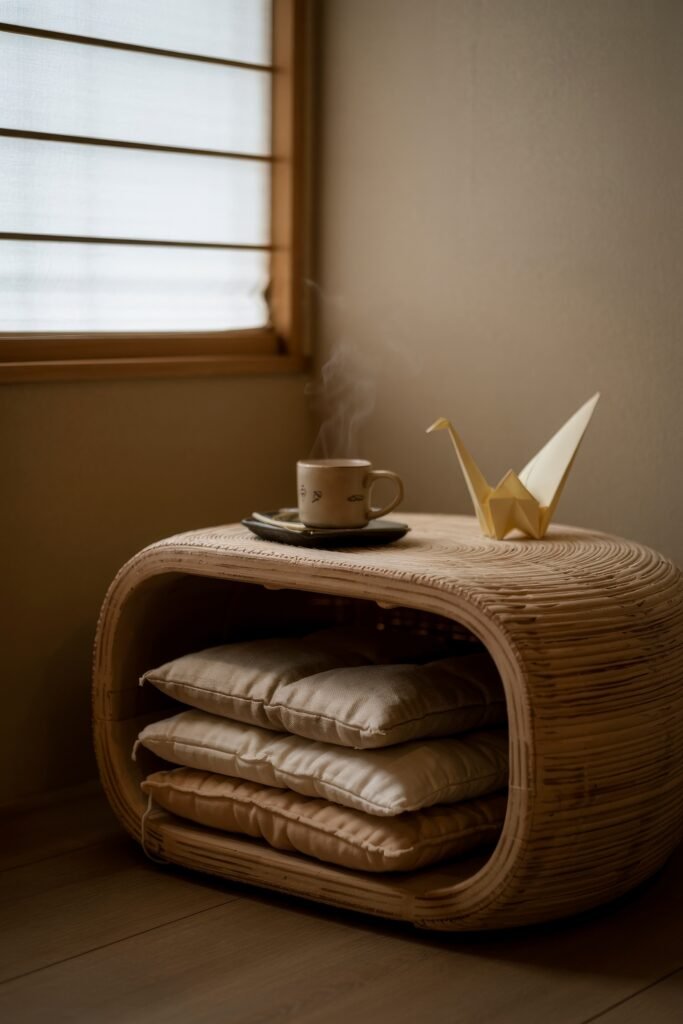

Hide Stuff in or Under Ottomans
Pile your zabuton into a hollow ottoman or storage bench. It’s great for guests and keeps your nook clutter-free.
Go Modular
Pick cushions with washable covers so they’re easy to toss in the wash or change with the seasons. You can mix and match to suit your mood.
Your seat becomes your storage—and suddenly, you have way more room.
Practical hacks and tips: Keep a few extra covers handy so you can swap them out for a quick deep clean or a fun style update.
Floating Shelves as Miniature Tokonoma Displays
In traditional Japanese rooms, a tokonoma is the spot to show off beautiful things. Even in a tiny nook, you can steal the idea.

Rotating Shelf Displays
Install some floating shelves above your table and show off a favorite vase, a pretty sake bottle, or little seasonal decorations.
DIY with Found Wood
If you’re into crafts, build shelves from that cool piece of wood you found at the flea market. It gives your nook history and style.
Your shelves become a changing art piece—so breakfast is never boring.
How to style: Switch out your shelf decor each season for a fresh, new focal point. Even a single flower or little trinket does the trick.
Cultivating Morning Rituals Through Design
Here’s my favorite part: Once your Japanese Breakfast Nook is all set up, it becomes a space to start your day with a little more intention. Rituals don’t have to be fancy—you can keep it as simple (or as quirky) as you like.
Bento-Style Meal Prep Stations
You know those Bento boxes with everything neatly in its spot? You can channel that energy in your prep zone.

Drawer Organization for Busy Mornings
Use shallow drawers under your table for stuff like pre-cut veggies, rice balls (onigiri), or little jars of overnight oats. Stack another organizer for toppings and extras.
Prep in Advance
Keep small jars of pickles or sauces in the fridge—they add flavor and color when you’re sleepy and rushed.
Breakfast assembly starts feeling more like a fun routine than a race against the clock.
A quick how-to: Freeze soup or sauce in ice cube trays for single-serve portions. Pop one out, heat, and you’re ready to go.
Meditative Tea Preparation Zones
There’s something calming about making tea—no need for a fancy tea master hat.
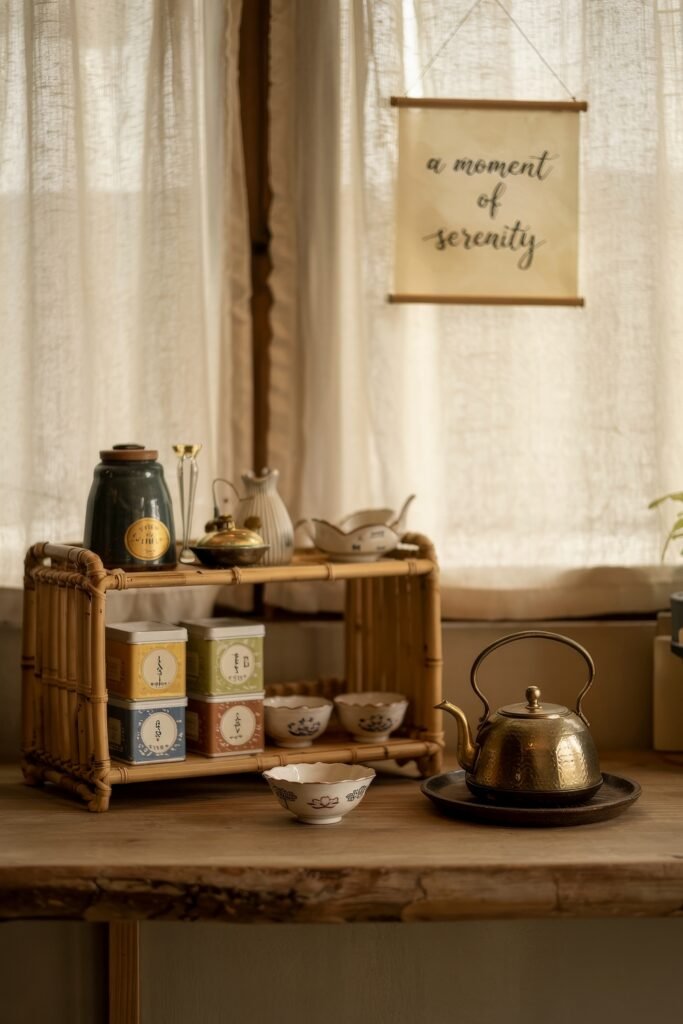
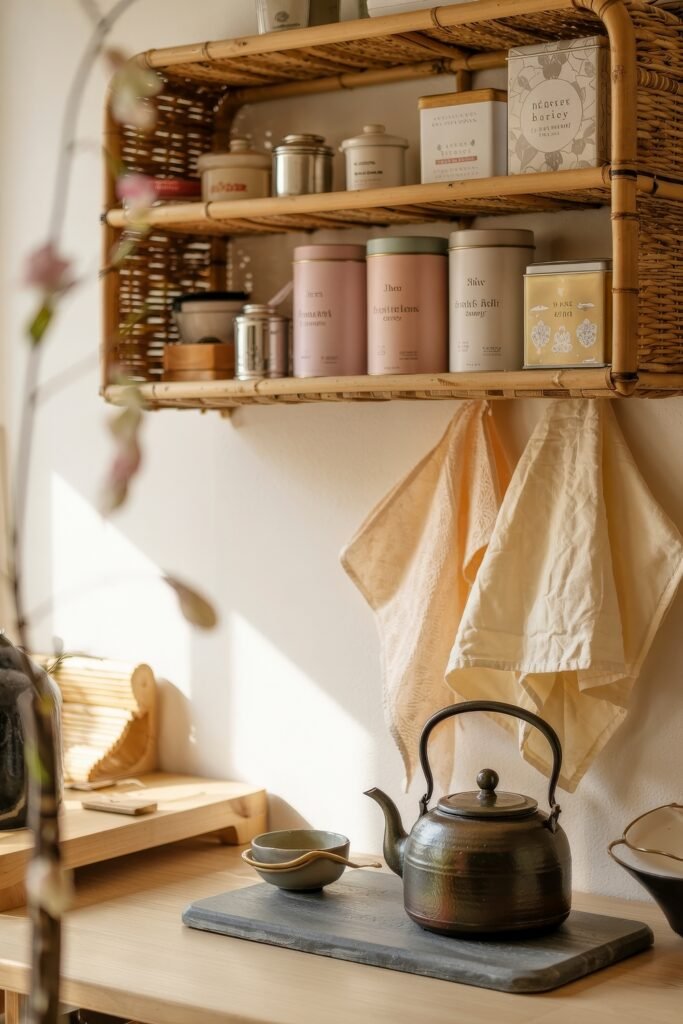
Set Up a Tea Corner
Use a little shelf for your tea tins and cups, and set a small countertop nearby for your kettle. Hang a soft curtain or towel for visual calm.
Make It a Ritual
Fill a dish with water for rinsing your spoon, or switch out teas by the season (sakura in spring, barley in winter). The point is to slow down for a moment or two.
A peaceful tea zone can reset your whole morning.
Quick tip: If you only have room for one shelf, make it count—keep your prettiest mug and favorite tea where you can see them every day.
Seasonal Flower Arrangements for Daily Renewal
Bringing a bit of nature into your nook is the fastest way to make mornings feel new again.
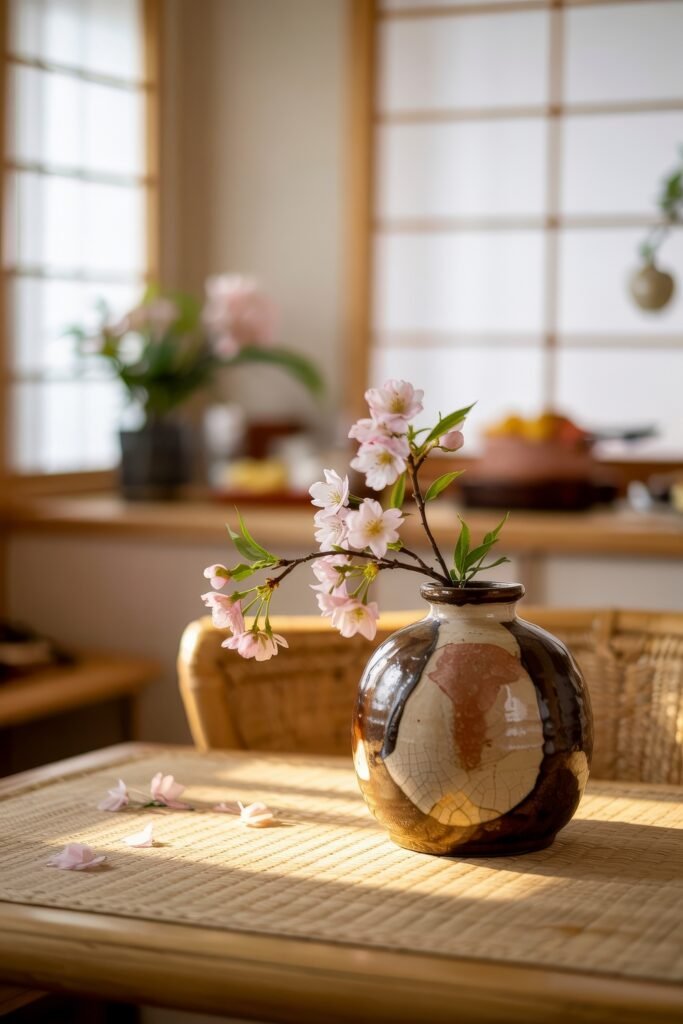

Simple, Changeable Flower Setups
Stick a small vase on your table with whatever’s in season—maybe one cherry blossom in spring, or a fiery red maple leaf in fall.
Try Pressed Flowers
If you want something long-lasting, press flowers or branches in a frame. Rotate them out when the seasons change.
A little flower or branch can actually make you pause, even if you’re just grabbing a quick bite before work.
A short tip: Get outside and forage for branches or wildflowers—it’s free and makes your arrangements feel extra special and unique.
Conclusion
So, let’s recap the best bits: First, a Japanese Breakfast Nook brings instant calm and style, even to the smallest kitchen corner. Second, keeping things tidy and choosing cozy textures seriously boosts the chill vibes. And third, with smart furniture and storage tricks, your nook can double as an office or even a hangout spot.
Want to get started? Try swapping in a chabudai table or adding a comfy zabuton cushion where you sit. Or just declutter one shelf and see how much lighter your space feels. Don’t be afraid to play around! If something doesn’t work? No stress—move it, swap it, or add a funky plant.
I’d love to know what ideas you’re most excited to try (or which ones you think I totally missed). Got your own hacks or breakfast rituals? Drop a comment and let’s chat about it! Oh, and if you want even more inspiration, definitely check out our Pinterest board all about Japanese Kitchen styles. There’s a ton of eye candy there!


